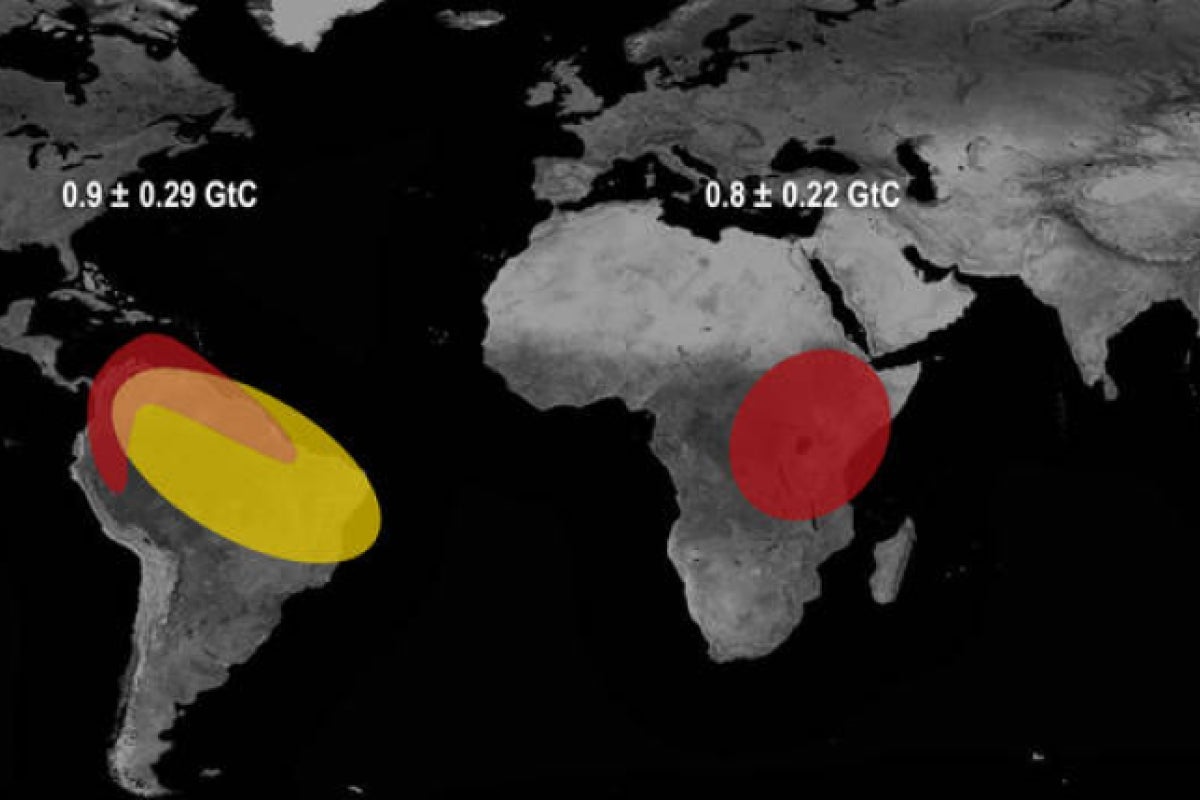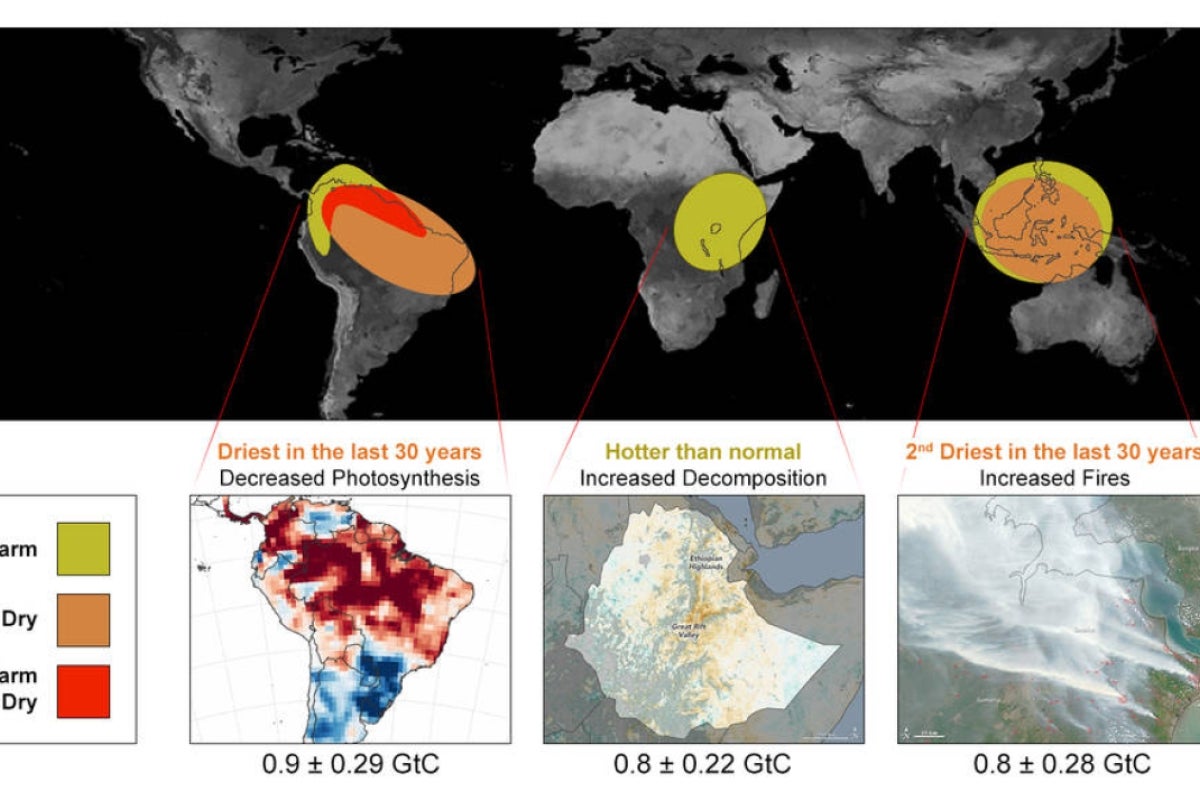ASU scientist contributes to NASA study pinpointing cause of Earth’s record CO2 spike

Artist rendition of the OCO-2 Observatory. Image by JPL/NASA
A new NASA study, with support from an Arizona State University atmospheric scientist, provides space-based evidence that Earth’s tropical regions were the cause of the largest annual increases in atmospheric carbon dioxide concentration seen in at least 2,000 years.
Scientists suspected the 2015–16 El Niño, one of the largest on record, was responsible. But exactly how has been a subject of ongoing research. Analyzing the first 32 months of data from NASA’s Orbiting Carbon Observatory-2 (OCO-2) satellite, researchers conclude that impacts of El Niño-related heat and drought occurring in tropical regions of South America, Africa and Indonesia were responsible for the record spike in global carbon dioxide. While each of these regions responded differently, all added to the increase.
The journal Science is publishing the findings beginning Oct. 13 as part of a collection of five research papers based on this data.
“These three tropical regions released 2.5 gigatons [a gigaton is 1 billion tons] more carbon into the atmosphere than they did in 2011,” said Junjie Liu, lead author of the study and researcher at NASA’s Jet Propulsion Laboratory (JPL). “Our analysis shows this extra carbon dioxide explains the difference in atmospheric carbon dioxide growth rates between 2011 and the peak years of 2015-16. OCO-2 data allowed us to quantify how the net exchange of carbon between land and atmosphere in individual regions is affected during El Niño years.”
Using the new satellite data, Liu’s team, including ASU Professor Kevin Gurney, analyzed how Earth’s land areas contributed to the record atmospheric carbon dioxide concentration increases.
They found that the total amount of carbon released into the atmosphere from all land areas increased by 3 gigatons in 2015 due to the El Niño, which is a reoccurring warming of water in the Pacific Ocean. About 80 percent of that amount — or 2.5 gigatons — came from natural processes occurring in tropical forests in South America, Africa and Indonesia, with each region contributing roughly the same amount.
“These important results are a testament to NASA leadership in integrating data from our group and others with state-of-the-art modeling to answer critical questions about our climate future,” said Gurney, an atmospheric scientist and ecologist with the ASU School of Life Sciences.
OCO-2 satellite provides global, precise CO2 coverage to observe and understand changes. Video by NASA/JPL-Caltech
Gurney, an expert in carbon cycling science, provided one of the core datasets to the simulations reflected in the article. In addition, he assisted with analysis of the study’s results. Also a senior sustainability scientist with the Julie Ann Wrigley Global Institute of Sustainability, he added: “The results of this study reflect another potential accelerant to climate change.”
The team compared the 2015 findings to those from a reference year (2011), using carbon dioxide data from the Japan Aerospace Exploration Agency’s Greenhouse Gases Observing Satellite. In 2011, weather in the three tropical regions was normal and the amount of carbon absorbed and released by them was in balance.
In 2015 and 2016, the OCO-2 satellite recorded atmospheric carbon dioxide increases that were 50 percent larger than the average increase seen in years preceding these observations. These measurements are consistent with those made by the National Oceanic and Atmospheric Administration. That increase was about 3 parts per million per year (or 6.3 gigatons of carbon).
In recent years, the average annual increase has been closer to 2 parts per million of carbon dioxide per year — or 4 gigatons of carbon. These record increases occurred even though emissions from human activities in the 2015–16 are estimated to have remained roughly the same as before El Niño.
OCO-2, a NASA satellite launched in 2014, gathers global measurements of atmospheric carbon dioxide with the resolution, precision and coverage needed to understand how this important greenhouse gas — the principal human-produced driver of climate change — moves through the Earth’s system at regional scales, and how it changes over time.
From its vantage point in space, this satellite can make roughly 100,000 measurements of atmospheric carbon dioxide each day, around the world.
“Understanding how the carbon cycle in these regions responded to El Niño will enable scientists to improve carbon cycle models, which should lead to improved predictions of how our planet may respond to similar conditions in the future,” said OCO-2 Deputy Project Scientist Annmarie Eldering of JPL. “The team’s findings imply that if future climate brings more or longer droughts, as the last El Niño did, more carbon dioxide may remain in the atmosphere, leading to a tendency to further warm Earth."
The research team also concluded that if future climate becomes more like the climate during El Niño, Earth may lose the carbon-removal services of its tropical forests.
Institutions involved in the study include NASA Jet Propulsion Laboratory; National Center for Atmospheric Research in Boulder, Colorado; University of Toronto in Canada; Colorado State University; Caltech in Pasadena, California; and Arizona State University in Tempe, Arizona.
More Science and technology

4 ASU researchers named senior members of the National Academy of Inventors
The National Academy of Inventors recently named four Arizona State University researchers as senior members to the prestigious…

Transforming Arizona’s highways for a smoother drive
Imagine you’re driving down a smooth stretch of road. Your tires have firm traction. There are no potholes you need to swerve to…

The Sun Devil who revolutionized kitty litter
If you have a cat, there’s a good chance you’re benefiting from the work of an Arizona State University alumna. In honor of…



